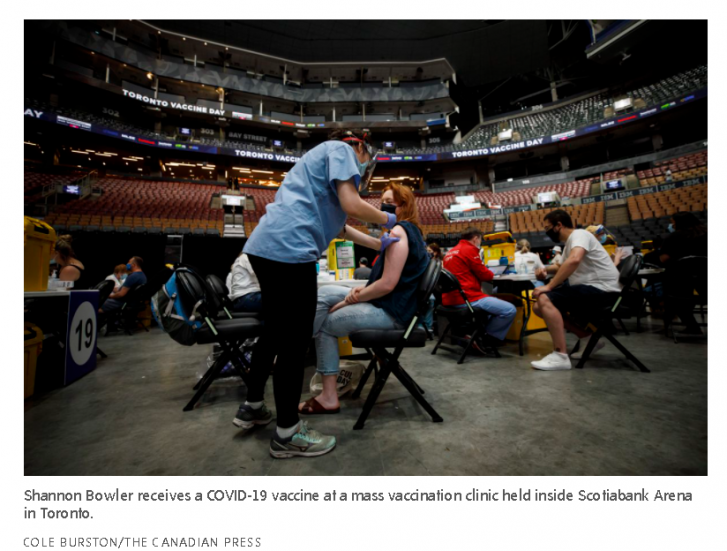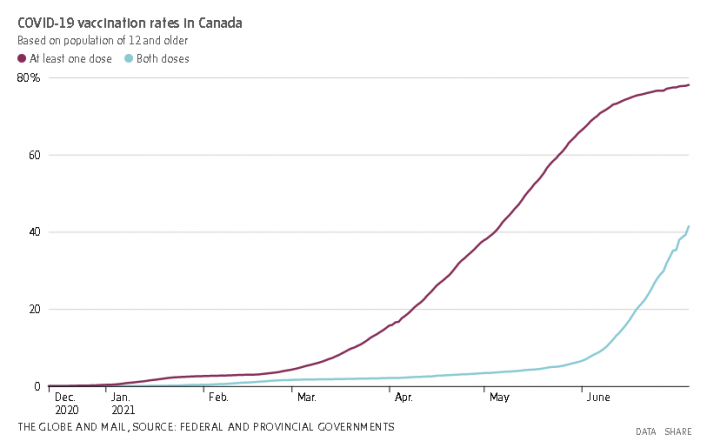The number of people getting their first COVID-19 vaccine doses is plateauing across the country, heightening the need to target harder-to-reach groups if Canada is going to achieve the vaccination levels needed to control the spread of infection.
As of Monday, 78 per cent of those eligible to be vaccinated in Canada have received at least one dose, and 41 per cent were fully vaccinated, making the country one of the most immunized in the world. Among the Group of Seven nations, Canada ranks second next to Britain with the highest number of doses administered per 100 people.

However, within provinces and territories, there are pockets with low vaccination rates across the country.
In the High Level health unit in northern Alberta, for example, 21 per cent of the eligible population had received at least one dose, and in Manitoba, 19 per cent of the eligible population in the municipality of Stanley had received at least one dose.
While the number of people receiving second doses continues to climb, those receiving their first doses have stalled at fewer than 100,000 a day since June 20.
With the rise of more transmissible variants, some epidemiologists estimate at least 80 per cent to 90 per cent Loading…of the eligible population will need to be fully vaccinated to keep COVID-19 rates under control.
Reaching those levels will be critical as we head into the fall, when people start spending more time indoors again at the same time the highly infectious Delta variant is expected to become the dominant variant of the virus in most of the country, said Cordell Neudorf, professor in the department of community health and epidemiology at the University of Saskatchewan.
“That’s when we expect the next wave to hit, unless we get high enough immunization coverage,” Dr. Neudorf said.

Now that those most willing and able to get immunized have received at least one vaccine, health authorities must ramp up their efforts to vaccinate groups that are more difficult to reach, said Nazeem Muhajarine, an epidemiologist and professor of community health and epidemiology at the University of Saskatchewan.
And that will require different targeted approaches, he said, since those who remain unvaccinated are a heterogenous group. They include people who are willing to be vaccinated but have difficulty accessing clinics, individuals who have lingering questions about the safety of vaccines and those who refuse to be vaccinated altogether.
The latter, whose refusal is generally ideologically driven, are a minority, making up an estimated 10 per cent of the population, Dr. Muhajarine said. Another 12 per cent to 14 per cent of Saskatchewan adults he has been tracking say they are hesitant about getting vaccinated.
“It’s the hesitant group that we need to be able to convert get a vaccine,” he said. “They’re not saying they would not get one, but they’re also saying they will not readily line up, be the first in line.”
To get more of these individuals immunized, Dr. Muhajarine said vaccines need to be made a lot more available and easy to access, so that people can simply go to a clinic within walking distance to get one, or to a nearby service agency where others speak the same language, instead of mass vaccination sites, which can be daunting for some to navigate.
“We have to really make it like turning a tap and getting water out of a tap; it’d be that easy,” he said.
Those who remain unvaccinated tend to be concentrated in certain geographical areas within a province or city, so pop-up clinics and other strategies are needed to bring vaccines to them instead of asking people to travel, he added. In Saskatchewan, for example, there are higher percentages of unvaccinated people in the South West and South East zones than around Saskatoon, he said.
Michelle Driedger, a professor in the department of community health sciences at the University of Manitoba, said some individuals in rural communities say they don’t feel the urgency to get vaccinated, since they feel their risk of COVID-19 is relatively low because they don’t regularly interact with many people.
Others question why they need to bother getting vaccinated when so many others are immunized, and still others feel reluctant because they interpret the frequent pivots and updates in recommendations from health authorities as a sign the authorities don’t know what’s going on and can’t be trusted, she said.
In focus groups Dr. Driedger has conducted, participants responded positively to having local doctors or other people with expertise and knowledge who live within their community address their questions and share information, she said. By contrast, they largely did not trust initiatives like a provincial lottery that gave people a chance to win money if they received their vaccines, expressing “you can’t buy people,” she said.
As provinces open up, those who are unvaccinated will be at greater risk of catching COVID-19 than they have been previously, since they’ll more likely be exposed by going out and interacting with others, said Caroline Colijn, a mathematician who specializes in infectious disease at Simon Fraser University in Burnaby, B.C.
Data from Ontario show unvaccinated individuals now make up the vast majority of cases. In a news conference on Tuesday, the province’s new Chief Medical Officer of Health, Kieran Moore, said 83.2 per cent of the 29,380 COVID-19 cases reported between May 15 and June 12 had not been vaccinated at all, 15.6 per cent were partially vaccinated and just 1.2 per cent were fully vaccinated.
“Where we stand as of today … we are risking having more COVID around, maybe substantially more,” Dr. Colijn said, but added she is hopeful that with most people vaccinated, the amount of severe disease will not be enough to challenge the health care systems again.
Even so, she said getting as much as 95 per cent of eligible people vaccinated is not out of reach, and should be the goal, especially since Statistics Canada data have shown more than 75 per cent of Canadians say they are willing to be vaccinated.
“We need to at least aim high,” Dr. Colijn said. “That will give us so much stronger protection in the face of some new variant that comes along or even the Delta that we have now, that it will be well worth it.”
Article From: Globe and Mail
Author: WENCY LEUNG, CHEN WANG

